9 - Automate Deterministic Analysis
This tutorial will familiarize you with the Automate Compute feature of RocPlane by automating a RocPlane Deterministic analysis.
Topics Covered in this Tutorial:
- Deterministic Analysis RocPlane Model
- Input Excel File Format
- Adding Input Excel File(s) to Automate Compute File Queue
- Output RocPlane Automate Compute Results File
- RocPlane Automate Compute Error Log
Finished Product:
The finished products of this tutorial can be found in the Tutorial 12 Automate Compute - Deterministic Analysis folder, located in the Examples > Tutorials folder in your RocPlane installation folder. Inside, you will find:
- Tutorial 09 Automate Compute - Deterministic_base file.pln4 RocPlane model file setup for automation
- Tutorial 09 Automate Compute - Deterministic_inputs.xlsx Excel input file
- Tutorial 09 Automate Compute - Deterministic_inputs folder containing the computed results files
1.0 Introduction
The Automate Compute option helps users quickly generate results for several RocPlane analysis cases at a time by reading in various model inputs from Excel. In this tutorial, we will automate the computation of three unique Deterministic cases (i.e., three wedges).
2.0 Creating a New File
If you have not already done so, run the RocPlane program by double-clicking the RocPlane icon in your installation folder or by selecting Programs > Rocscience > RocPlane > RocPlane in the Windows Start menu.
When the program starts, a default model is automatically created. If you do NOT see a model on your screen:
- Select File > New

Whenever a new file is created, the default input data forms a valid wedge, as shown in the image below.
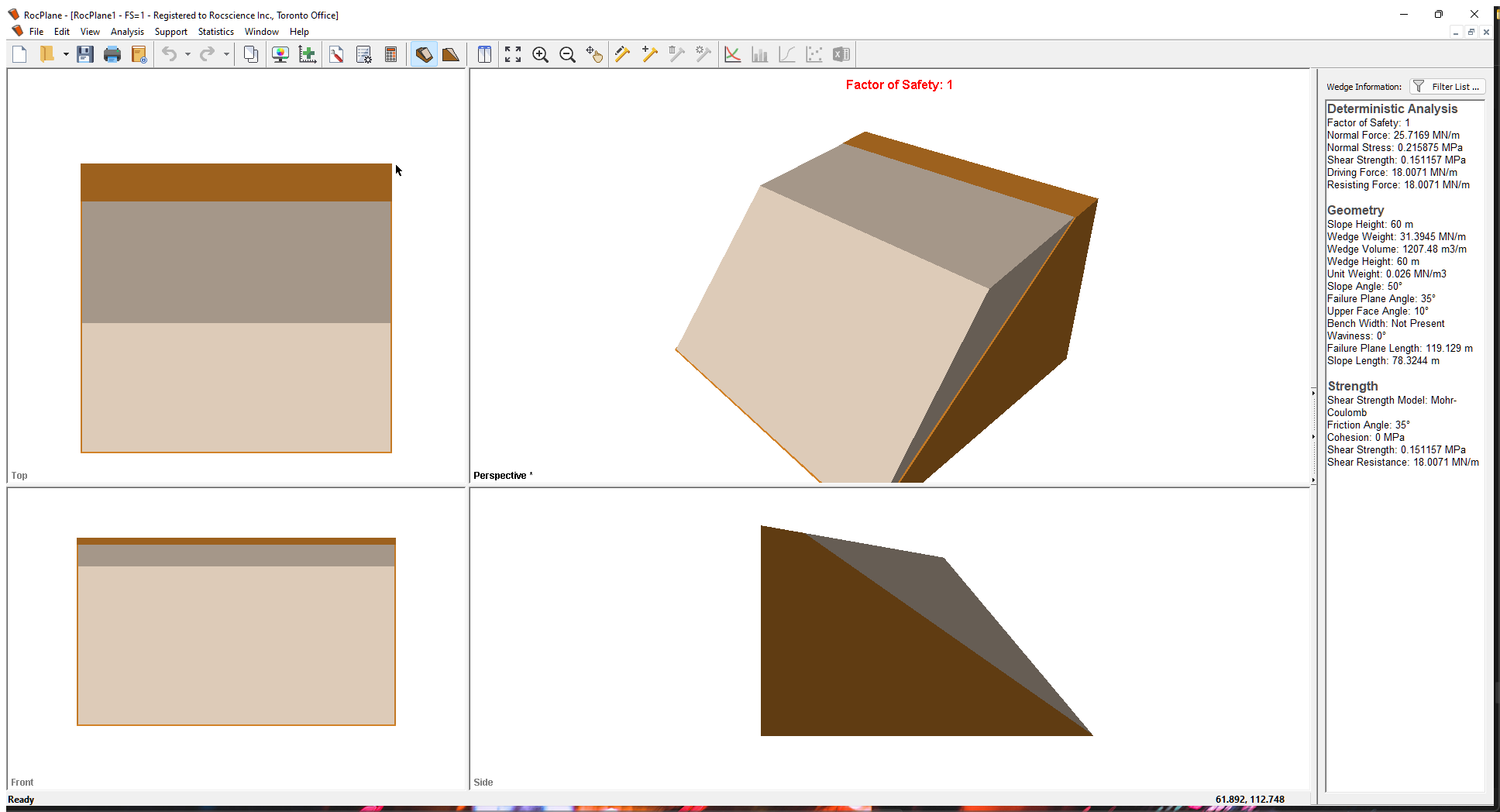
If the RocPlane application window is not already maximized, maximize it now so that the full screen is available for viewing the model.
Before we are ready to run Automate Compute, we must first set up the model environment in the following dialogs:
- Project Settings
- Input Data
- Scale Wedge
3.0 Project Settings
First, set the model Units, and Analysis Type.
- Select Analysis > Project Settings
 from the menu to open the Project Settings dialog.
from the menu to open the Project Settings dialog. - Set the Units = Metric, stress as kPa.
- Set the Analysis Type = Deterministic.
- Select OK to close the dialog.
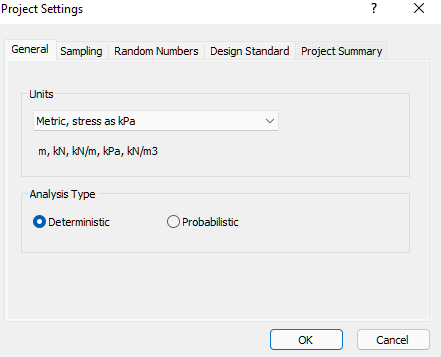
4.0 Input Data
Next, set the optional input data.
- Select Analysis > Input Data
 from the menu to open the Deterministic Input Data dialog.
from the menu to open the Deterministic Input Data dialog. - Navigate to the Geometry tab.
- Slope Angle
- Slope Height
- Unit Weight
- Failure Plane Angle
- Failure Plane Waviness
- Upper Face Angle
- Navigate to the Strength tab.
- Set Shear Strength Model = Mohr-Coulomb.
- Friction Angle
- Cohesion
- Navigate to the Forces tab.
- Navigate to the Water tab.
- Select OK to close the dialog.
We will keep all the check box controls in the default state. Keep in mind that the following are required input parameters that have to be specified later on in the Input Excel File:
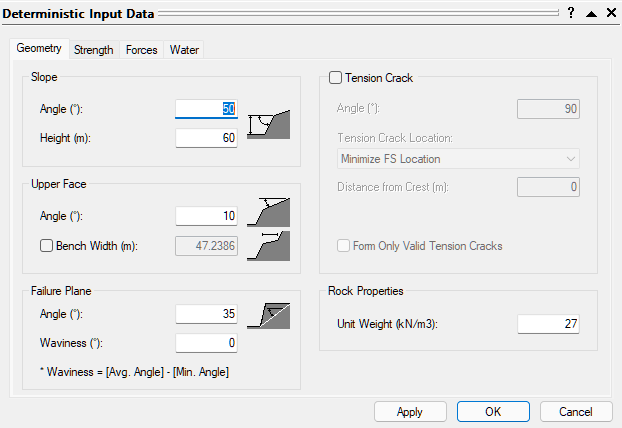
Keep in mind that the following are required input parameters that have to be specified later on in the Input Excel File:
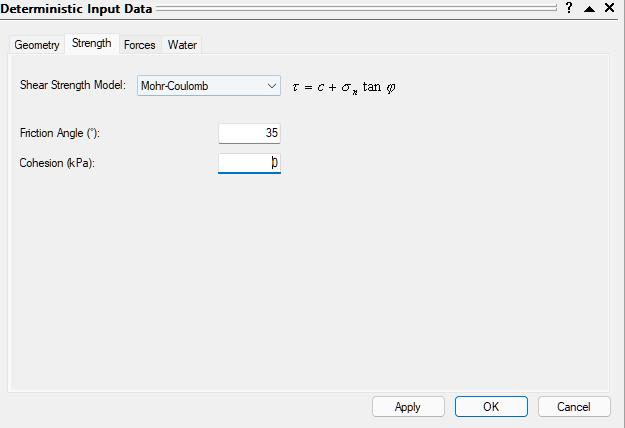
We will leave all the check box controls in the default state (unchecked). No input parameters are required since no Seismic or External Forces are applied.
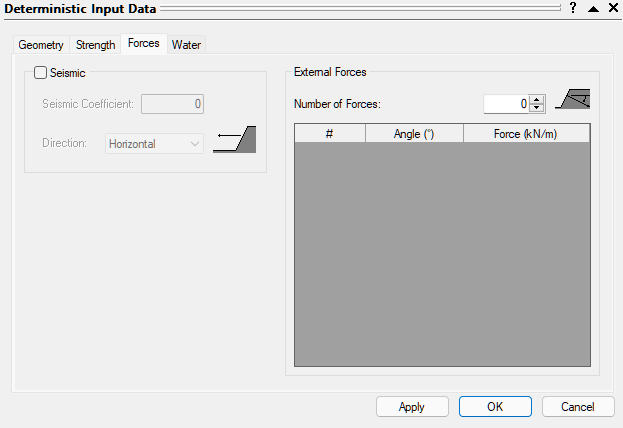
We will leave all the check box controls in the default state (unchecked). No input parameters are required since no Ponded Water Pressure or Joint Water Pressure are applied.
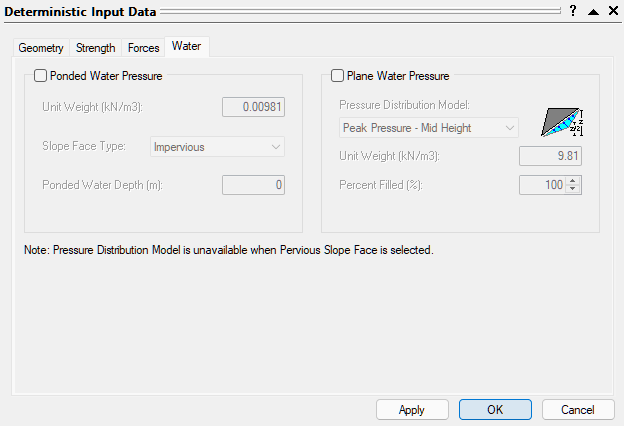
5.0 Input Excel File
Now, let's take a look at the structure of the input Excel file.
- Obtain the RocPlane Deterministic Excel Template by selecting Analysis > Automate Compute > Deterministic Excel Template.
A Read-Only Excel workbook titled RocPlane Automation Template_Deterministic.xlsx will be automatically opened (if you have Excel installed on your local machine).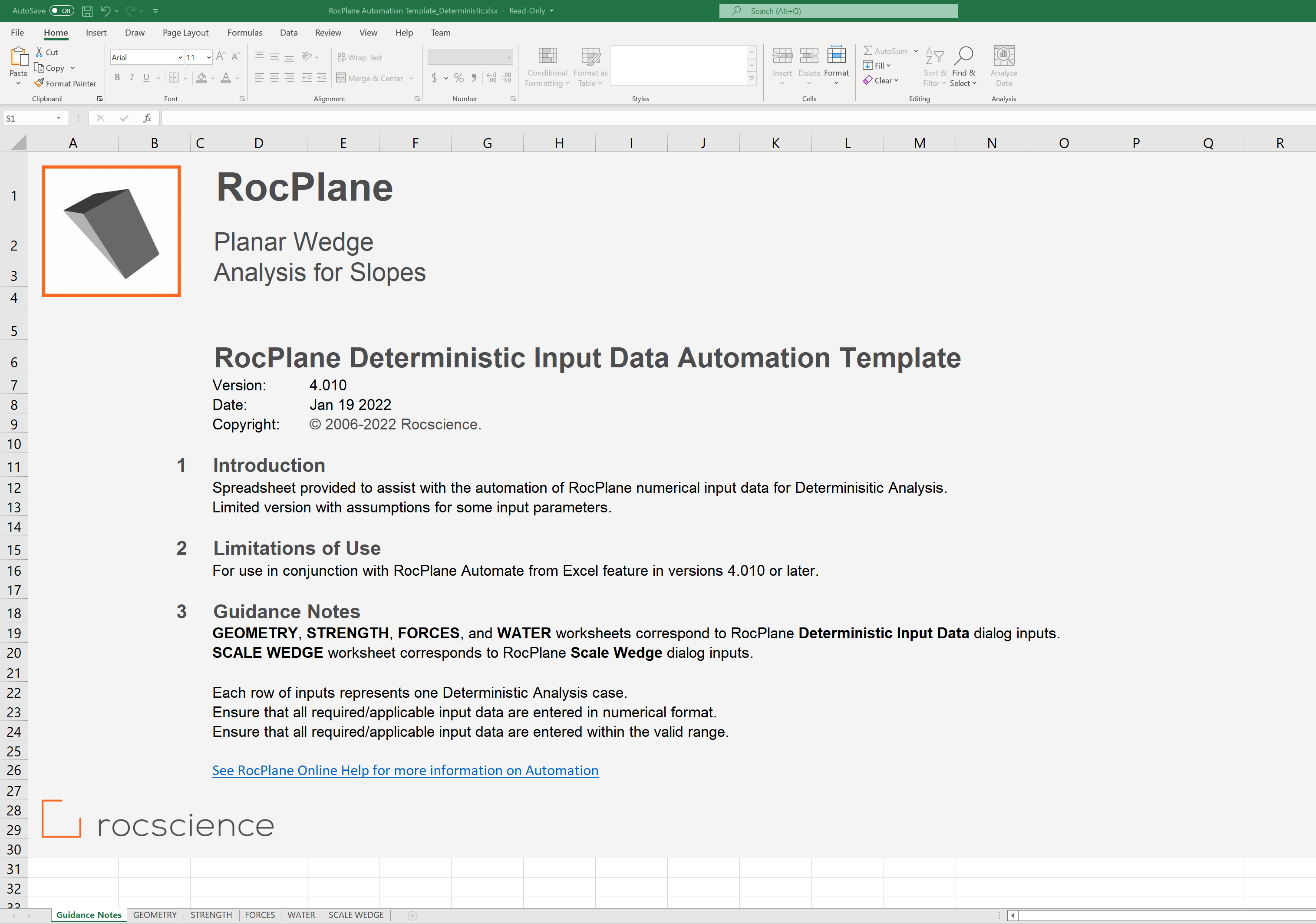
The RocPlane Deterministic Input Data Automation Template Excel workbook and worksheets are protected to prevent any accidental modification to the tab structure and headers. The input Excel template contains 5 worksheets for inputting numerical parameters for automation. - Create a folder called Tutorial 09 Automate Compute - Deterministic.
5.1 Geometry
- Navigate to the GEOMETRY worksheet.
- Under the Wedge ID column, provide the names of the wedges. We will name them arbitrarily Wedge A, Wedge B, and Wedge C. Each row in the input Excel file represents one Deterministic Analysis case in RocPlane.
- Enter the following:
- Navigate to the STRENGTH worksheet.
- Under the Wedge ID column, provide the names of the wedges (Wedge A, Wedge B, and Wedge C ).
- Enter the following:
Wedge ID | Slope | Failure Plane | Upper Face | |||
Angle | Height | Unit Weight | Angle | Waviness | Angle | |
Wedge A | 50 | 60 | 27 | 35 | 0 | 10 |
Wedge B | 45 | 50 | 25 | 20 | 0 | 0 |
Wedge C | 55 | 40 | 26 | 45 | 0 | -10 |
The GEOMETRY worksheet should look like this:

Wedge ID | Strength | |
|---|---|---|
C | Phi | |
Wedge A | 0 | 35 |
Wedge B | 300 | 30 |
Wedge C | 200 | 25 |
5.2 Strength
The STRENGTH worksheet should look like this:

- We do not need to enter any data in the FORCES, WATER, or SCALE WEDGE worksheets since those are not applicable.
- Save the Excel file as Tutorial 09 Automate Compute - Deterministic_inputs.xlsx to the Tutorial 09 Automate Compute - Deterministic folder previously created.
We are now ready to automate computations in RocPlane by reading from the input Excel file.
6.0 Automate from Excel
Return back to the RocPlane model.
The Automate Compute dialog allows you to add Excel input automation files to the queue, select a an output format, and compute the results.
6.1 ADD FILES TO FILE QUEUE
To add multiple files to the File Queue:
- Select Analysis > Automate from Excel
 from the menu to open the Automated Compute dialog.
from the menu to open the Automated Compute dialog.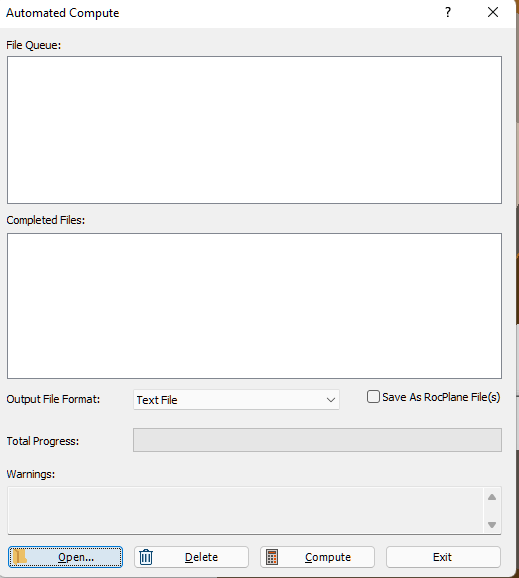
- Click the Open
 button to open a standard dialog to choose an Excel input file. Navigate to the Tutorial 09 Automate Compute - Deterministic folder and select the Tutorial 09 Automate Compute - Deterministic_inputs.xlsx file.
button to open a standard dialog to choose an Excel input file. Navigate to the Tutorial 09 Automate Compute - Deterministic folder and select the Tutorial 09 Automate Compute - Deterministic_inputs.xlsx file.
You will see the Excel input file appear under the File Queue list box.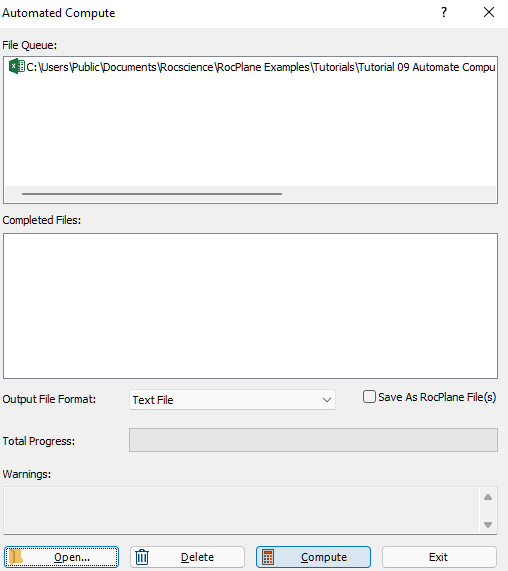
7.0 Output Result Files
Results files are automatically generated and saved into the same directory as the input Excel file after Automated Compute is complete. Before we run Compute, first ensure that the Output File Format is set to the desired format. Users can select from either Text File or Excel format.
7.1 TEXT FILE FORMAT
While still in the Automated Compute dialog:
- Set the Output File Format dropdown to Text File.
- Select the Compute button to start the automated computing process.
- When all files have finished computing, select Exit to close the dialog.
The Total Progress can be seen at the bottom of the dialog. When files have finished computing, they will appear in the Completed Files list box.
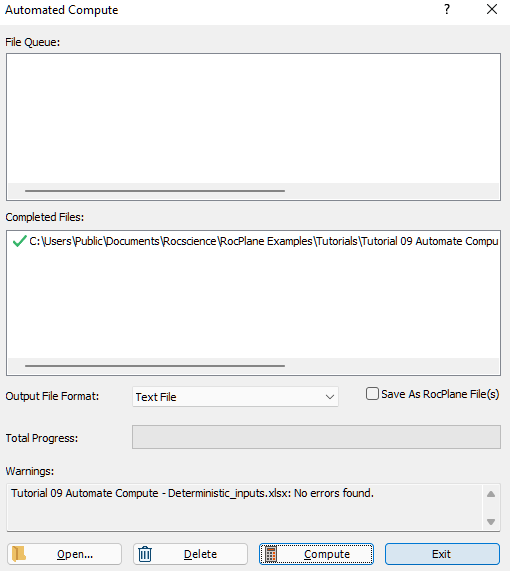
For each input Excel file, a text file (.txt) containing all results data is generated.
For a Deterministic Analysis (Tutorial 09 Automate Compute - Deterministic_inputs.xlsx), the results data for all cases are outputted following the header row. Each row of data represents one analysis case (i.e., one wedge). Each data type is separated by a comma (,) for easy parsing.
- Take a look at the Results.txt result file.

7.2 EXCEL FILE FORMAT
Now, we will do the same as before, but this time we will generate the results as an Excel output file format.
- Select Analysis > Automate from Excel
 from the menu to open the Automated Compute dialog.
from the menu to open the Automated Compute dialog. - Click the Open
 button to open a standard dialog to choose an Excel input file. Navigate to the Tutorial 09 Automate Compute - Deterministic folder and select the Tutorial 09 Automate Compute - Deterministic.xlsx file.
button to open a standard dialog to choose an Excel input file. Navigate to the Tutorial 09 Automate Compute - Deterministic folder and select the Tutorial 09 Automate Compute - Deterministic.xlsx file. - Set the Output File Format dropdown to Excel File.
- Select the Save As RocPlane File(s) checkbox. This will save each automated compute case as a RocPlane file.
- Click the Compute button to start the automated computing process.
- Since there are already Text File results in the results directory, a popup will appear with the message "Results folder(s) not empty. Duplicated results file(s) will be overwritten. Continue?". Click Yes.
- When all files have finished computing, click Exit to close the dialog.
You will see the Excel input file appear under the File Queue list box.
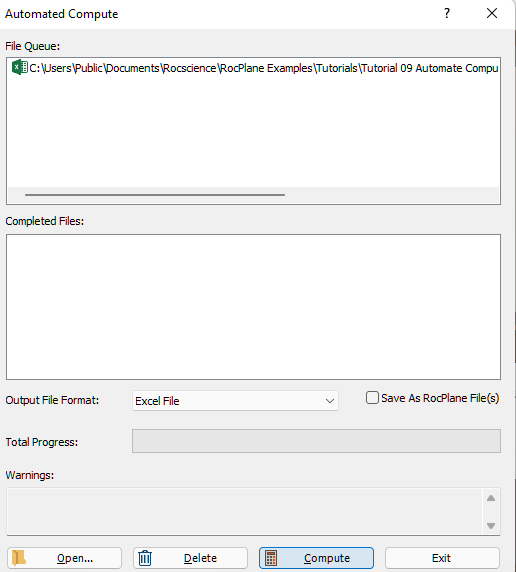
For each input Excel file, an Excel file (.xlsx) containing all results data is generated.
For a Deterministic Analysis (Tutorial 09 Automate Compute - Deterministic.xlsx), the results data for all cases are outputted following the header row. Each row of data represents one analysis case (i.e., one wedge). Each data type is separated by column.
- Take a look at the Results.xlsx result file.

8.0 Error Log
As you may have noticed, an Error Log is also generated for each input Excel file. For each input Excel file, an Error Log text file (Automate Compute Error Log.txt) is generated, and saved into the same directory as the output file directories. Always check that the Error Log reports "No errors found" before post-processing the raw results data. If any errors do occur as a result of missing (i.e., blank cells) or invalid inputs, the Error Log will indicate which worksheet(s) and cell(s) are problematic.
This concludes the tutorial. You are now ready for the next tutorial, Tutorial 10 - Automate Probabilistic Analysis from Excel in RocPlane.